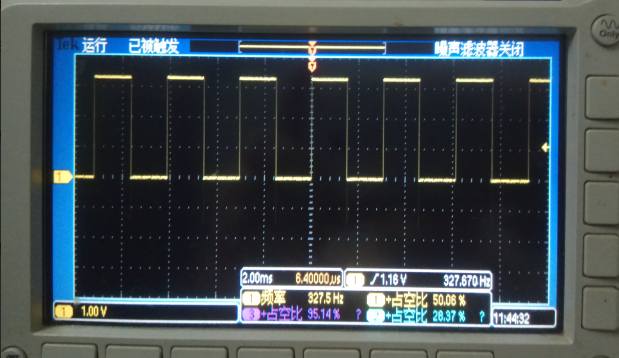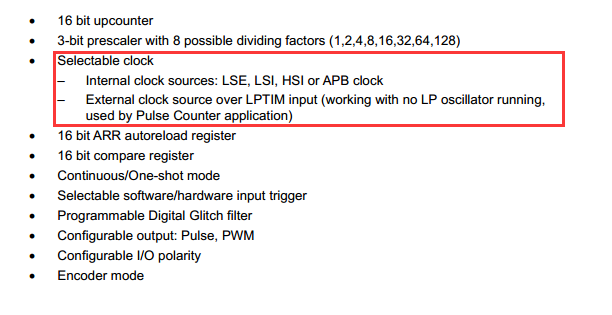|
|
说明:
测试的官方例子:LPTIM_PWM_LSE。
使用LPTIM的好处是系统处于睡眠,停机状态可以正常工作(除了待机模式)。
这个例子选择了LSE作为LPTIM1的时钟源,输出一个占空比50%,频率327.68KHz的波形。
并且设了一个用户按键唤醒停机模式,唤醒后停止PWM输出。

波形输出:


测试代码:
此功能重点还是函数HAL_LPTIM_Init的参数配置学习。
- /* Private typedef -----------------------------------------------------------*/
- /* Private define ------------------------------------------------------------*/
- /* Set the Maximum value of the counter (Auto-Reload) that defines the Period */
- #define PeriodValue (uint32_t) (100 - 1)
- /* Set the Compare value that defines the duty cycle */
- #define PulseValue (uint32_t) (50 - 1)
- /* Private macro -------------------------------------------------------------*/
- /* Private variables ---------------------------------------------------------*/
- /* LPTIM handle declaration */
- LPTIM_HandleTypeDef LptimHandle;
- /* Clocks structure declaration */
- RCC_PeriphCLKInitTypeDef RCC_PeriphCLKInitStruct;
- /* Private function prototypes -----------------------------------------------*/
- static void SystemClock_Config(void);
- static HAL_StatusTypeDef LSE_ClockEnable(void);
- static void Error_Handler(void);
- static void CPU_CACHE_Enable(void);
- /* Private functions ---------------------------------------------------------*/
- /**
- * @brief Main program
- * @param None
- * @retval None
- */
- int main(void)
- {
- /* Enable the CPU Cache */
- CPU_CACHE_Enable();
-
- /* STM32H7xx HAL library initialization:
- - Systick timer is configured by default as source of time base, but user
- can eventually implement his proper time base source (a general purpose
- timer for example or other time source), keeping in mind that Time base
- duration should be kept 1ms since PPP_TIMEOUT_VALUEs are defined and
- handled in milliseconds basis.
- - Set NVIC Group Priority to 4
- - Low Level Initialization
- */
- HAL_Init();
- /* Configure the system clock to 400 MHz */
- SystemClock_Config();
- /* Configure LED2 */
- BSP_LED_Init(LED2);
-
- /* User push-button (EXTI_Line15_10) will be used to wakeup the system from Stop mode */
- BSP_PB_Init(BUTTON_USER, BUTTON_MODE_EXTI);
- /* Enable the LSE Clock */
- if (LSE_ClockEnable() != HAL_OK)
- {
- Error_Handler();
- }
-
- /* ### - 1 - Re-target the LSE to Clock the LPTIM Counter ################# */
- /* Select the LSE clock as LPTIM peripheral clock */
- RCC_PeriphCLKInitStruct.PeriphClockSelection = RCC_PERIPHCLK_LPTIM1;
- RCC_PeriphCLKInitStruct.Lptim1ClockSelection = RCC_LPTIM1CLKSOURCE_LSE;
- HAL_RCCEx_PeriphCLKConfig(&RCC_PeriphCLKInitStruct);
-
-
- /* ### - 2 - Initialize the LPTIM peripheral ############################## */
- /*
- * Instance = LPTIM1
- * Clock Source = APB or LowPowerOSCillator (in this example LSE is
- * already selected from the RCC stage)
- * Counter source = External event.
- * Clock prescaler = 1 (No division)
- * Counter Trigger = Software trigger
- * Output Polarity = High
- * Update mode = Immediate (Registers are immediately updated after any
- * write access)
- */
- LptimHandle.Instance = LPTIM1;
-
- LptimHandle.Init.Clock.Source = LPTIM_CLOCKSOURCE_APBCLOCK_LPOSC;
- LptimHandle.Init.Clock.Prescaler = LPTIM_PRESCALER_DIV1;
- LptimHandle.Init.CounterSource = LPTIM_COUNTERSOURCE_INTERNAL;
- LptimHandle.Init.Trigger.Source = LPTIM_TRIGSOURCE_SOFTWARE;
- LptimHandle.Init.OutputPolarity = LPTIM_OUTPUTPOLARITY_HIGH;
- LptimHandle.Init.UpdateMode = LPTIM_UPDATE_IMMEDIATE;
- LptimHandle.Init.Input1Source = LPTIM_INPUT1SOURCE_GPIO;
- LptimHandle.Init.Input2Source = LPTIM_INPUT2SOURCE_GPIO;
-
- /* Initialize LPTIM peripheral according to the passed parameters */
- if (HAL_LPTIM_Init(&LptimHandle) != HAL_OK)
- {
- Error_Handler();
- }
- /* ### - 3 - Start counting in interrupt mode ############################# */
- /*
- * Period = 99
- * Pulse = 49
- * According to this configuration, the duty cycle will be equal to 50%
- */
- if (HAL_LPTIM_PWM_Start(&LptimHandle, PeriodValue, PulseValue) != HAL_OK)
- {
- Error_Handler();
- }
-
- /* ### - 4 - Enter in Stop mode ########################################### */
- HAL_PWR_EnterSTOPMode(PWR_LOWPOWERREGULATOR_ON, PWR_STOPENTRY_WFI);
-
- /* ### - 5 - Stop counting when leaving Stop mode ########################## */
- if (HAL_LPTIM_PWM_Stop(&LptimHandle) != HAL_OK)
- {
- Error_Handler();
- }
- /* Infinite Loop */
- while (1)
- {
- }
- }
- /**
- * @brief System Clock Configuration
- * The system Clock is configured as follow :
- * System Clock source = PLL (HSE BYPASS)
- * SYSCLK(Hz) = 400000000 (CPU Clock)
- * HCLK(Hz) = 200000000 (AXI and AHBs Clock)
- * AHB Prescaler = 2
- * D1 APB3 Prescaler = 2 (APB3 Clock 100MHz)
- * D2 APB1 Prescaler = 2 (APB1 Clock 100MHz)
- * D2 APB2 Prescaler = 2 (APB2 Clock 100MHz)
- * D3 APB4 Prescaler = 2 (APB4 Clock 100MHz)
- * HSE Frequency(Hz) = 8000000
- * PLL_M = 4
- * PLL_N = 400
- * PLL_P = 2
- * PLL_Q = 4
- * PLL_R = 2
- * VDD(V) = 3.3
- * Flash Latency(WS) = 4
- * @param None
- * @retval None
- */
- static void SystemClock_Config(void)
- {
- RCC_ClkInitTypeDef RCC_ClkInitStruct;
- RCC_OscInitTypeDef RCC_OscInitStruct;
- HAL_StatusTypeDef ret = HAL_OK;
-
- /*!< Supply configuration update enable */
- MODIFY_REG(PWR->CR3, PWR_CR3_SCUEN, 0);
- /* The voltage scaling allows optimizing the power consumption when the device is
- clocked below the maximum system frequency, to update the voltage scaling value
- regarding system frequency refer to product datasheet. */
- __HAL_PWR_VOLTAGESCALING_CONFIG(PWR_REGULATOR_VOLTAGE_SCALE1);
- while(!__HAL_PWR_GET_FLAG(PWR_FLAG_VOSRDY)) {}
-
- /* Enable HSE Oscillator and activate PLL with HSE as source */
- RCC_OscInitStruct.OscillatorType = RCC_OSCILLATORTYPE_HSE;
- RCC_OscInitStruct.HSEState = RCC_HSE_BYPASS;
- RCC_OscInitStruct.HSIState = RCC_HSI_OFF;
- RCC_OscInitStruct.CSIState = RCC_CSI_OFF;
- RCC_OscInitStruct.PLL.PLLState = RCC_PLL_ON;
- RCC_OscInitStruct.PLL.PLLSource = RCC_PLLSOURCE_HSE;
- RCC_OscInitStruct.PLL.PLLM = 4;
- RCC_OscInitStruct.PLL.PLLN = 400;
- RCC_OscInitStruct.PLL.PLLP = 2;
- RCC_OscInitStruct.PLL.PLLR = 2;
- RCC_OscInitStruct.PLL.PLLQ = 4;
- RCC_OscInitStruct.PLL.PLLVCOSEL = RCC_PLL1VCOWIDE;
- RCC_OscInitStruct.PLL.PLLRGE = RCC_PLL1VCIRANGE_2;
- ret = HAL_RCC_OscConfig(&RCC_OscInitStruct);
- if(ret != HAL_OK)
- {
- Error_Handler();
- }
-
- /* Select PLL as system clock source and configure bus clocks dividers */
- RCC_ClkInitStruct.ClockType = (RCC_CLOCKTYPE_SYSCLK | RCC_CLOCKTYPE_HCLK | RCC_CLOCKTYPE_D1PCLK1 | RCC_CLOCKTYPE_PCLK1 | \
- RCC_CLOCKTYPE_PCLK2 | RCC_CLOCKTYPE_D3PCLK1);
- RCC_ClkInitStruct.SYSCLKSource = RCC_SYSCLKSOURCE_PLLCLK;
- RCC_ClkInitStruct.SYSCLKDivider = RCC_SYSCLK_DIV1;
- RCC_ClkInitStruct.AHBCLKDivider = RCC_HCLK_DIV2;
- RCC_ClkInitStruct.APB3CLKDivider = RCC_APB3_DIV2;
- RCC_ClkInitStruct.APB1CLKDivider = RCC_APB1_DIV2;
- RCC_ClkInitStruct.APB2CLKDivider = RCC_APB2_DIV2;
- RCC_ClkInitStruct.APB4CLKDivider = RCC_APB4_DIV2;
- ret = HAL_RCC_ClockConfig(&RCC_ClkInitStruct, FLASH_LATENCY_4);
- if(ret != HAL_OK)
- {
- Error_Handler();
- }
- }
- /**
- * @brief Enable External Low Speed Clock (LSE)
- * @param None
- * @retval Status
- */
- static HAL_StatusTypeDef LSE_ClockEnable(void)
- {
- RCC_OscInitTypeDef RCC_OscInitStruct;
-
- /* Enable LSE clock */
- RCC_OscInitStruct.OscillatorType = RCC_OSCILLATORTYPE_LSE;
- RCC_OscInitStruct.LSEState = RCC_LSE_ON;
- RCC_OscInitStruct.PLL.PLLState = RCC_PLL_NONE;
- return (HAL_RCC_OscConfig(&RCC_OscInitStruct));
- }
- /**
- * @brief This function is executed in case of error occurrence.
- * @param None
- * @retval None
- */
- static void Error_Handler(void)
- {
- /* Turn LED2 on */
- BSP_LED_On(LED2);
- while (1)
- {
- }
- }
- /**
- * @brief CPU L1-Cache enable.
- * @param None
- * @retval None
- */
- static void CPU_CACHE_Enable(void)
- {
- /* Enable I-Cache */
- SCB_EnableICache();
- /* Enable D-Cache */
- SCB_EnableDCache();
- }
- #ifdef USE_FULL_ASSERT
- /**
- * @brief Reports the name of the source file and the source line number
- * where the assert_param error has occurred.
- * @param file: pointer to the source file name
- * @param line: assert_param error line source number
- * @retval None
- */
- void assert_failed(uint8_t *file, uint32_t line)
- {
- /* User can add his own implementation to report the file name and line number,
- ex: printf("Wrong parameters value: file %s on line %d\r\n", file, line) */
- /* Infinite loop */
- while (1)
- {
- }
- }
|
|









 发表于 2018-8-24 00:22:26
发表于 2018-8-24 00:22:26



 发表于 2018-8-24 09:13:55
发表于 2018-8-24 09:13:55
 楼主
楼主

